

































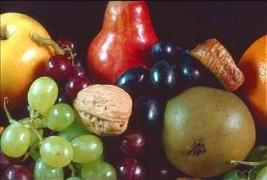 It is very easy to read gardening advice. However, when you actually start to dig that first hole you will quickly discover how much work is really involved. Therefore please be prepared for some really hard work if you decide to plant a small orchard, or a vineyard, or a berry patch.
It is very easy to read gardening advice. However, when you actually start to dig that first hole you will quickly discover how much work is really involved. Therefore please be prepared for some really hard work if you decide to plant a small orchard, or a vineyard, or a berry patch.| 1 Part Top Soil |
| 1 Part Humus (or Peat) |
| 1 Part Composted Cow Manure |
| 1/2 Part Pure Sand (the type used in a child's sand box or when mixing cement) |
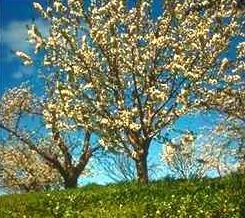 The key to being successful with fruit trees is to select a variety that is suited for your specific geographical area. Do not assume that just because a specific variety of fruit tree is available at your local garden shop that it will do well in your area. For example, the Bartlett pear tree is the most popular pear tree in the United States and it is usually available for sale each spring in almost every garden store in the United States. However, the Bartlett pear tree does not do well in some southeastern states. The reason the garden shops in the southeast have it is because each spring people come into the store and ask for it by name. Therefore these garden shops sell their customers what they ask for.
The key to being successful with fruit trees is to select a variety that is suited for your specific geographical area. Do not assume that just because a specific variety of fruit tree is available at your local garden shop that it will do well in your area. For example, the Bartlett pear tree is the most popular pear tree in the United States and it is usually available for sale each spring in almost every garden store in the United States. However, the Bartlett pear tree does not do well in some southeastern states. The reason the garden shops in the southeast have it is because each spring people come into the store and ask for it by name. Therefore these garden shops sell their customers what they ask for. Golden Delicious is the best choice as a universal pollinator because it is a mid-season bloomer and its blooms will overlap early and late season apple varieties.
Golden Delicious is the best choice as a universal pollinator because it is a mid-season bloomer and its blooms will overlap early and late season apple varieties. Cherries: Cherry trees are frequently grown from seed, which is the pit at the center of the cherry. If you can find fresh cherries for sale in your area, and if the cherries are named, then you can buy a pint of them, eat the cherries, and save the pits of the cherries and plant them. However, please read the following information because you may need a pollinator.
Cherries: Cherry trees are frequently grown from seed, which is the pit at the center of the cherry. If you can find fresh cherries for sale in your area, and if the cherries are named, then you can buy a pint of them, eat the cherries, and save the pits of the cherries and plant them. However, please read the following information because you may need a pollinator.| Group One | Group Two | Group Three |
| Bing | Sodus | Black Eagle |
| Lambert | Van | Black Tartarian |
| Napoleon | Venus | Early Rivers |
| National | Knights Early Black | |
| Royal Ann |
 Pears: Some pear trees are self-fruitful and some are not. Pear trees will usually grow straight up instead of branching out to the sides. It is not unusual for some pear trees to live 40 or 50 years. The most common pear tree in the United States is the Bartlett pear but it will not grow in every geographical area. Anjou (D'Anjou) and Bartlett are partially self-fruitful and they may be used to pollinate other varieties of pear trees. Other good heirloom varieties are Bosc, Comice, and Seckle.
Pears: Some pear trees are self-fruitful and some are not. Pear trees will usually grow straight up instead of branching out to the sides. It is not unusual for some pear trees to live 40 or 50 years. The most common pear tree in the United States is the Bartlett pear but it will not grow in every geographical area. Anjou (D'Anjou) and Bartlett are partially self-fruitful and they may be used to pollinate other varieties of pear trees. Other good heirloom varieties are Bosc, Comice, and Seckle.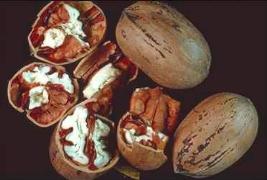 Pecan Trees: Pecan trees do well in southern climates. Each tree has a female flower (the pistillate) and a male flower (the staminate). The female flower appears on the new growth each season and the male flower appears on last year's growth. On some trees the female flower matures first and later the male flower matures (called a protogynous variety). On other trees the male flower matures first and later the female flower matures (called a protandrous variety). Therefore it is critical to have at least two different varieties of pecan trees in close proximity to each other, and one of those trees should be a protogynous variety and the other tree should be a protandrous variety. This will ensure good cross fertilization because in the early part of the season the female flower on one tree will be mature when the male flower on the other tree will be mature. A little later in the season the opposite flower on each tree will be mature. Most employees in a garden center are not aware of this information and the only thing they will tell you is that you just need two different varieties of pecan trees. This is not true. If you have two trees and both have the male flowers mature first then cross-pollination will not occur. You need to have the female flowers on one tree mature at the same time the male flower is mature on another tree. The following table lists some of the more common varieties of each type of pecan tree. Please pick at least one variety from each side of the following table if you desire to have a good crop of pecans each year.
Pecan Trees: Pecan trees do well in southern climates. Each tree has a female flower (the pistillate) and a male flower (the staminate). The female flower appears on the new growth each season and the male flower appears on last year's growth. On some trees the female flower matures first and later the male flower matures (called a protogynous variety). On other trees the male flower matures first and later the female flower matures (called a protandrous variety). Therefore it is critical to have at least two different varieties of pecan trees in close proximity to each other, and one of those trees should be a protogynous variety and the other tree should be a protandrous variety. This will ensure good cross fertilization because in the early part of the season the female flower on one tree will be mature when the male flower on the other tree will be mature. A little later in the season the opposite flower on each tree will be mature. Most employees in a garden center are not aware of this information and the only thing they will tell you is that you just need two different varieties of pecan trees. This is not true. If you have two trees and both have the male flowers mature first then cross-pollination will not occur. You need to have the female flowers on one tree mature at the same time the male flower is mature on another tree. The following table lists some of the more common varieties of each type of pecan tree. Please pick at least one variety from each side of the following table if you desire to have a good crop of pecans each year.| Female then Male | Male then Female |
| Protogynous | Protandrous |
| Choctaw * | Caddo ** |
| Curtis *** | Cape Fear |
| Elliot ** | Desirable *** |
| Harris Super | Farley |
| Mahan | Hastings * |
| Mahan-Stuart | Moore |
| Moneymaker | Success |
| Schley * | |
| Stuart | |
| Wichita ** |
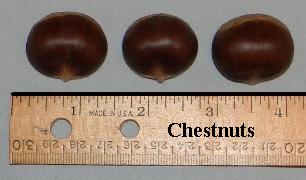
 Grapes are highly recommended because:
Grapes are highly recommended because: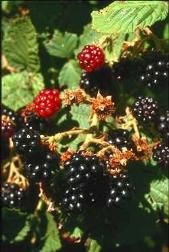 Blackberry Bushes: Blackberries will thrive and spread far beyond their original planting site. Their underground root system grows and grows and new stalks shoot up each spring from these underground roots. The first year the stalk grows between four to six feet tall. The second year the stalk produces blackberries. Then the stalk dies. However, the underground roots continue to grow and spread out and the blackberry patch will continue to get larger and larger with each passing year. The easiest way to start blackberries is to dig up the roots of some wild blackberries and transplant those roots in a very sunny location on your property. However, there is now a "thornless blackberry variety" for sale at some garden shops and if I were starting a blackberry patch from scratch today then that is probably the type of blackberry I would invest in.
Blackberry Bushes: Blackberries will thrive and spread far beyond their original planting site. Their underground root system grows and grows and new stalks shoot up each spring from these underground roots. The first year the stalk grows between four to six feet tall. The second year the stalk produces blackberries. Then the stalk dies. However, the underground roots continue to grow and spread out and the blackberry patch will continue to get larger and larger with each passing year. The easiest way to start blackberries is to dig up the roots of some wild blackberries and transplant those roots in a very sunny location on your property. However, there is now a "thornless blackberry variety" for sale at some garden shops and if I were starting a blackberry patch from scratch today then that is probably the type of blackberry I would invest in.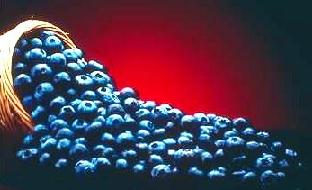 Rabbiteye Blueberries: They were named because the fruit starts off pink, which is the same color as the eyes of a white rabbit. As the berries ripen they gradually turn a bright blue. The rabbiteye blueberry is usually grown in the southeastern United States. Rabbiteye blueberries have almost no diseases, they are easy to grow, and they will live about twenty-years. They will grow to a height of between six to seven feet tall. Some good varieties of rabbiteye blueberries are Climax, Powder Blue, Premier, and Tifblue. I have two plants of each of these four different varieties planted in one long row on my property, with the early varieties at one end of the row and the late varieties at the opposite end of the row. Every year all the varieties produce flowers at almost the same exact time and later the blueberries all mature at almost the same exact time. Some of the blueberries on all the different plants will ripen and turn a bright blue and they will contain enough sugar to be harvested. Therefore I pick the ripe blueberries off all my bushes the same day. Several days later a few more blueberries on each bush will be ripe and I will harvest them. This will continue for about four weeks and at that time I will have harvested all the blueberries on all the bushes. The reason I mention this is because I no longer believe that it makes any difference whether a blueberry variety is named an early, mid-season, or late variety. They will all mature at approximately the same rate over the same approximate time period.
Rabbiteye Blueberries: They were named because the fruit starts off pink, which is the same color as the eyes of a white rabbit. As the berries ripen they gradually turn a bright blue. The rabbiteye blueberry is usually grown in the southeastern United States. Rabbiteye blueberries have almost no diseases, they are easy to grow, and they will live about twenty-years. They will grow to a height of between six to seven feet tall. Some good varieties of rabbiteye blueberries are Climax, Powder Blue, Premier, and Tifblue. I have two plants of each of these four different varieties planted in one long row on my property, with the early varieties at one end of the row and the late varieties at the opposite end of the row. Every year all the varieties produce flowers at almost the same exact time and later the blueberries all mature at almost the same exact time. Some of the blueberries on all the different plants will ripen and turn a bright blue and they will contain enough sugar to be harvested. Therefore I pick the ripe blueberries off all my bushes the same day. Several days later a few more blueberries on each bush will be ripe and I will harvest them. This will continue for about four weeks and at that time I will have harvested all the blueberries on all the bushes. The reason I mention this is because I no longer believe that it makes any difference whether a blueberry variety is named an early, mid-season, or late variety. They will all mature at approximately the same rate over the same approximate time period.

